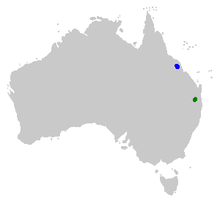Rheobatrachus vitellinus
[2] It was restricted to the rainforest areas of the Clarke Range in Eungella National Park and the adjacent Pelion State Forest in central eastern Queensland.
This species was also much darker in colour, usually pale brown, and like the southern gastric-brooding frogs its skin was bumpy and had a slimy mucus coating.
The northern gastric-brooding frog was only recorded in pristine rainforests where the only form of human disturbance was poorly defined walking tracks.
[6] Scientists are making progress in their efforts to bring the gastric-brooding frog species back to life using somatic-cell nuclear transfer (SCNT), a method of cloning.
These scientists from the University of Newcastle Australia led by Prof Michael Mahony, who was the scientist who first discovered the northern gastric-brooding frog, Simon Clulow and Prof Mike Archer from the University of New South Wales hope to continue using somatic-cell nuclear transfer methods to produce an embryo that can survive to the tadpole stage.
